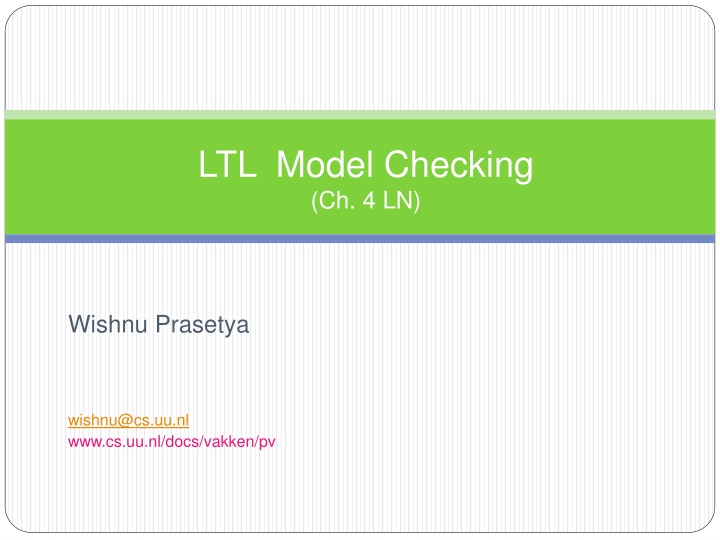
Overview of LTL Model Checking and Program Verification
This overview delves into the abstract models of programs, temporal properties verification through model checking, runtime properties like Hoare triples, linear temporal logic, finite state automaton abstraction, program composition modeling, intersection concept, and parallel composition in the context of computer science.
Download Presentation

Please find below an Image/Link to download the presentation.
The content on the website is provided AS IS for your information and personal use only. It may not be sold, licensed, or shared on other websites without obtaining consent from the author. If you encounter any issues during the download, it is possible that the publisher has removed the file from their server.
You are allowed to download the files provided on this website for personal or commercial use, subject to the condition that they are used lawfully. All files are the property of their respective owners.
The content on the website is provided AS IS for your information and personal use only. It may not be sold, licensed, or shared on other websites without obtaining consent from the author.
E N D
Presentation Transcript
LTL Model Checking (Ch. 4 LN) Wishnu Prasetya wishnu@cs.uu.nl www.cs.uu.nl/docs/vakken/pv
Overview This pack : Abstract model of programs Temporal properties Verification (via model checking) algorithm Concurrency 2
Run-time properties Hoare triple : express what should hold when the program terminates. Many programs are supposed to work continuously They should be safe They should not dead lock No process should starve Linear Temporal Logic (LTL) Originally designed by philosophers to study the way that time is used in arguments Based on a number of operators to express relation over time: next , always , eventually Belong to the class of modal logics Brought to Computer Science by Pnueli, 1977. 3
Finite State Automaton/Machine Abstraction of a real program Choices What information do we want to put in the states? In the arrows? How to model execution? a path through the FSA, staring at an initial state. Does it have to be finite? Do we need a concept of acceptance ? These choices influence what you can express, and how you can verify properties over executions. 0 1 4
FSA Described by (S, I, , R) S : the set of possible states I S : set of possible initial states : set of labels, to decorate the arrows. They model possible actions. R : S pow(S), the arrows R(s,a) is the set of possible next-states of a if executed on s non-deterministic 5
Program compositions can be modeled by operations over FSA We assume actions to be atomic. M1 ; M2 connect terminal states of M1 to M2 s initial states. M1 M2 only do executions that are possible in both M1 || M2 model parallel execution of M1 and M2 6
Intersection c (0,0) 0 0 a a a a (1,1) 1 1 a a (0,2) 2 Not something you typically do in real programs A useful concept for verification later. 7
Parallel composition c 0 0 || a b 1 1 Suppose M1 and M2 has no common action. Their parallel composition is basically the full product of M1 and M2 . So,if each component has n number of states, constructing || over k components produces an automaton with nkstates. 8
Parallel composition with synchronized actions c 0 0 a a 1 1 Suppose we require that any action a 1 2 has to be executed together (synchronizedly) by both automata. 9
Lets add labels Consider these set of labels , Prop = { isOdd x, x>0 }. The labeling is describe by this function V: 0 1 V(0) = { isOdd x } V (1) = { isOdd x, x>0 } So far, the only things we know about the states is that they differ from each other. Let s extend the available information with propositions. 10
Kripke Structure A finite automaton ( S, s0, R, Prop, V ) S : the set of possible states, with s0 the initial state. R : S pow(S), the arrows R(s) is the set of possible next-states from s non-deterministic Prop : set of atomic propositions abstractly modeling state properties. V : S pow(Prop), labeling function a V(s) means a holds in s, else it does not hold. No concept of accepting states. 11
Prop It consists of atomic propositions. We ll require them to be non-contradictive. That is, for any subset Q of Prop : /\Q /\ /\{ p | p Prop /\ p Q} is satisfiable. Else you may get inconsistent labeling. This is the case if they are independent of each other. Example: Prop = { x>0 , y>0 } is ok. Prop = { x>0 , x>1 } is not ok. E.g. the subset { x>1 } is inconsistent. 12
Execution An execution is a path through your automaton, starting from an initial state. Let s focus on properties of infinite executions All executions are assumed infinite Extend each terminal state (states with no successor) in the original Krikpe with a stuttering loop. This induces an abstract execution: Nat pow(Prop) infinite sequence of the set of propositions that hold along that path. We ll often use the term execution and abstract execution interchangbly. 13
Example 0 { isOdd x } { isOdd x, x>0 } 1 Exec. : 0 0 1 1 ... Abs-exec: {isOdd x} , {isOdd x}, {isOdd x, x>0}, {isOdd x, x>0} , ... 14
LTL, informal meaning f // always f f f f f f f g X g // next g f f f f g f U g // f holds until g 15
You can combine operators ( p (true U q )) // whenever p holds, eventually q will hold p U ( q U r) true U p// eventually stabilizing to p true U p// eventually p will hold infinitely many often 16
Syntax ::= p // atomic proposition from Prop | | /\ | X | U Derived operators: \/ = ( /\ ) = \/ , , W , Interpreted over abstract executions. 17
Defining the meaning of temporal formulas First we ll define the meaning wrt to a single abstract execution. Let be such an execution: ,i |== |== = ,0 |== If P is a Kripke structure, P |== means that holds on all abstract executions of P that start from P s initial state 18
Meaning Let be an (abstract) execution. ,i |== p = p (i) // p Prop ,i |== = not ( ,i |== ) ,i |== /\ = ,i |== and ,i |== 19
Meaning ,i |== X = ,i+1 |== ,i |== U = there is a j i such that ,j |== and for all h, i h<j, we have ,h |== . 20
Example 0 { isOdd x } { isOdd x, x>0 } 1 Consider : {isOdd x} , {isOdd x}, {isOdd x, x>0}, {isOdd x, x>0} , ... |== isOdd x U x>0 Is this a valid property of the FSA? 21
Derived operators W R = true U = = \/ ( U ) = W ( /\ ) Eventualy Always Weak until Release 22
Some derived operators <> f // eventually f f f f f f f f f W g // weak until f f f f g f f f f f f g R f // releases f f f g,f 23
Past operators Useful, e.g. to say: if P is doing something with x, then it must have asked a permission to do so. previous ,i |== Y = holds in the previous state since ,i |== S = ,j |== for some j i, and for all j<k i we have ,j |== Unfortunately, not supported by SPIN. 24
Ok, so how can I verify M |== ? We can t directly check all executions infinite (in two dimensions). Try to prove it directly using the definitions? We ll take a look another strategy First, let s view abstract executions as sentences. View M as a sentence-generator. Define: L(M) = { | is an abs-exec of M } these are sentences over pow(Prop) 25
Representing as an automaton Let be the temporal formula we want to verify. Suppose we can construct automaton B that accepts exactly those infinite sentences over pow(Prop) for which holds. So B is such that : L(B ) = { | |== } 26
Re-express as a language problem Well, M |== iff There is no L(M) where does not hold. In other words, there is no L(M) that will be accepted by L(B ). So: M |== iff L(M) L(B ) = 27
Automaton with acceptance So far, all paths are accepted. What if we only want to accept some of them? Add acceptance states. Accepted sentence: aba and aa is accepted bb is not accepted. a q1 a b q2 b But this is for finite sentences. For infinite ...? 28
Buchi Automaton Pass an acceptance state infinitely many times. a q1 Examples ababa not an infinite a b ababab accepted q2 b abbbb not accepted! 29
Expressing temporal formulas as Buchi Use pow(Prop) as the alphabet of arrow-labels. Example: Xp ( = X p) We ll take Prop = { p } Indirectly saying that p is false. {p} {p} {p} We can drop this, since we only need to (fully) cover accepted sentences. 30
To make the drawing less verbose... Xp, using Prop = {p} * * So we have 4 subsets. Xp, using Prop = {p,q} Stands for all subsets of Prop that do not contain p; thus implying p does not hold . p p * * Stands for all subsets of Prop that contain p; thus implying p holds . p 31
Always and Eventually p []p p <>p * * p <>[]p p * 32
Until p U q : q * p q p U Xq : * * p 33
Not Until Formula: ( p U q ) Note first these properties: = qW p /\ q (pUq) = p /\ qW p /\ q (pWq) = p /\ qU p /\ q = qU p /\ q (also generally when p,q are LTL formulas) p,q p q * 34
Generalized Buchi Automaton []<>p /\ []<>q p q 2 0 1 * * * Sets of accepting states: F = { {1} , {2} } which is different than just F = { 1, 2 } in an ordinary Buchi. Every GBA can be converted to BA. 35
Difficult cases How about nested formulas like: (Xp) U q ( pUq ) Ur Their Buchi is not trivial to construct. Still, any LTL formula can be converted to a Buchi. SPIN implements an automated conversion algorithm; unfortunately it is quite complicated. 36
Check list M |== iff L(M) L(B ) = 1. How to construct B ? Buchi 2. We still have a mismatch, because M is a Kripke structure! Fortunately, we can easily convert it to a Buchi. 3. We still have to construct the intersection. 4. We still to figure out a way to check emptiness. 37
Label on state or label on arrow... a a b c generate the same sentences b c b c c b d generate the same sentences e d e 38
Converting Kripke to Buchi 0 { isOdd x } Single accepting set F, containing all states. { isOdd x, x>0 } z 1 { isOdd x } { isOdd x } 0 { isOdd x, x>0 } Generate the same (infinite) sentences! 1 { isOdd x, x>0 } 39
Computing intersection The Buchi version of Kripke M Rather than directly checking: L(BM) L(B ) = We check: L(BM B ) = We already discuss this! Execution over such an intersection is also called a lock-step execution. 40
Intersection Two buchi automata A and Bover the same alphabet The set of states are respectively SA and SB. starting at respectively s0A and s0B. Single accepting set, respectively FA and FB. FA is assumed to be SA A B can be thought as defining lock-step execution of both: The states : SA SB, starting at (s0A,s0B) Can make a transition only if A and B can both make the corresponding transition. A single acceptance set F; (s,t) is accepting if t FB. 41
Constructing Intersection, example p : isOdd x q : x>0 BM: { p,q } 0 1 { p } { p } BM B <>q : B <>q: a q (1,a) (0,a) { p } { p } 42
Verification Sufficient to have an algorithm to check if L(C) = , for the intersection-automaton C. L(C) iff there is a finite path from C s initial state to an accepting state f , followed by a cycle back to f . So, it comes down to a cycle finding in a finite graph! Solvable. The path leading to such a cycle also acts as your counter example! 43
Approaches View C = BM B as a directed graph. Approach 1 : 1. Calculate all strongly connected component (SCCs) of C (e.g. with Tarjan) . 2. Check if there is an SCC containing an accepting state, reachable from C s initial state. Approach 2, based on Depth First Search (DFS); can be made lazy : the full graph is constructed as-we-go, as you search for a cycle. Importantly, if M represents a parallel composition P1 || P2 || ... , this means that we can lazily construct BM. 44
DFS-approach (SPIN) DFS is a way to traverse a graph : DFS(u) { if (u visited) return ; visited.add(u) ; for (s next(u)) DFS(s) ; } This will visit all reachable nodes. You can already use this to check state assertions . 45
Example 0 4 1 2 3 46
Adding cycle detection DFS(u) { if (u visited) return ; visited.add(u) ; for each (s next(u)) { if (u accept) { visited2 = ; checkCycle (u,s) ; } DFS(s ) ; } } 47
checkCycle is another DFS checkCycle(root,s) { if (s = root) throw CycleFound ; if ( s visited2 ) return ; visited2.add(s) ; for each (t next(s)) checkCycle(root, t) ; } Can be extended to keep track of the path leading to the cycle counter example. See Lecture Notes. 48
Example 0 1 2 3 checkCycle(1,2) the node currently being processed root 49
Tweak: lazy model checking Remember that automaton to explore is C = BM B In particular, BM can be huge if M = P1 || P2 || ... Can we construct C lazily? Benefit : if a cycle is found (verification fails), effort is not wasted to first construct the full C. Of course if turns out to be valid, then C will in the end fully constructed. How to deal with concrete states (rather than abstract states a la Kripke) ? 50




